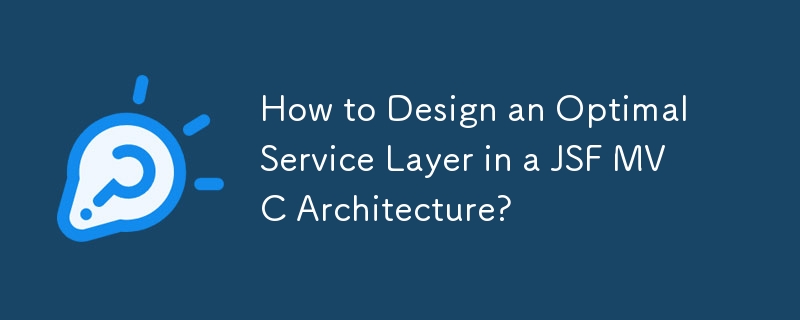

Service Layer Considerations in a JSF MVC Environment
In a JSF MVC architecture, the Service Layer serves as the bridge between the View (JSF components) and the Model (the data and business logic). When designing a Service Layer, there are several key considerations to ensure optimal design and performance.
Service Granularity
Avoid creating a monolithic Service that handles all business logic. Instead, consider breaking down services based on the main entities they manage. For instance, a UserService for User-related tasks, a ProductService for Product-related tasks, and so on. This approach promotes loose coupling and facilitates maintainability.
Service API
Java EE 6 provides EJB 3.1 as a comprehensive Service Layer API. EJB offers features such as transaction management and dependency injection, making it a suitable choice for service implementation. Alternatively, Spring can be used, though Java EE 6 has incorporated many of Spring's advantages.
Service Responsibility
The Service Layer should primarily handle business logic and interact with DAOs (e.g., JPA repositories) to access and manipulate data. It should not have any direct dependencies on JSF components or perform JSF-specific tasks. This ensures that the Service Layer can be reused across different front-ends (e.g., JAX-RS, servlets).
Transaction Management
A key advantage of using EJBs for Service Layer implementation is container-managed transactions. Each EJB method call represents a single database transaction, providing automatic rollback in case of exceptions. This maintains data integrity and simplifies transaction handling.
Additional Resources
To further explore these topics, you may wish to refer to the following resources:
The above is the detailed content of How to Design an Optimal Service Layer in a JSF MVC Architecture?. For more information, please follow other related articles on the PHP Chinese website!
 How to solve the problem of missing ssleay32.dll
How to solve the problem of missing ssleay32.dll
 How to open the terminal window in vscode
How to open the terminal window in vscode
 Is A5 bigger or B5 paper bigger?
Is A5 bigger or B5 paper bigger?
 The role of parseint function
The role of parseint function
 The difference between arrow functions and ordinary functions
The difference between arrow functions and ordinary functions
 How to define an array
How to define an array
 How much is Snapdragon 8gen2 equivalent to Apple?
How much is Snapdragon 8gen2 equivalent to Apple?
 fil currency price real-time price
fil currency price real-time price
 SpringBoot project building steps
SpringBoot project building steps




